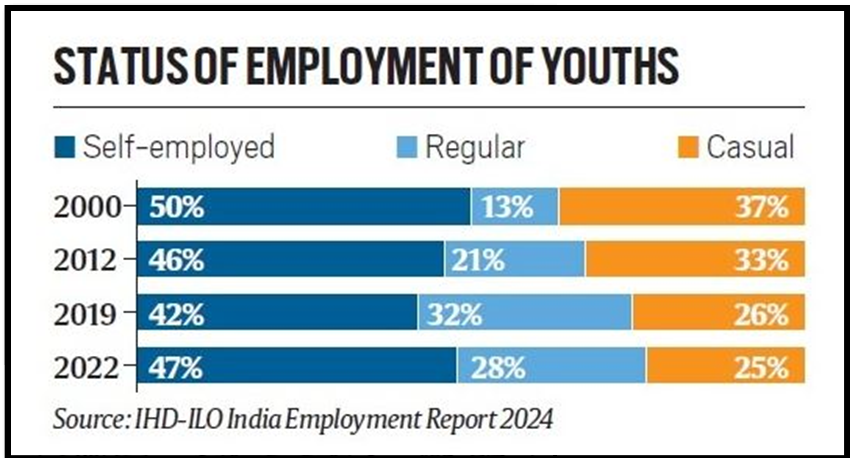WHY IS UNEMPLOYMENT HIGH AMONG THE YOUTH?
Syllabus:
- GS-3– Unemployment and related economic issues
Focus :
- The India Employment Report 2024, prepared jointly by the Institute of Human Development (IHD) and the International Labour Organization (ILO), and released on March 26, revolves around “youth employment, education and skills.”
Source:- ILO
India Employment Report 2024: Key Findings
- The report focuses on youth employment, education, and skills, analyzing labor market trends for two decades, including the COVID-19 period.
- India’s working-age population (15-59 years) has increased from 61% in 2011 to 64% in 2021, with projections reaching 65% by 2036.
- Despite increased educational enrollment among youth (18% in 2000 to 35% in 2022), their participation in economic activities decreased from 52% to 37% during the same period.
| About Unemployment :
· The ratio of jobless people to the labor force is used to calculate the unemployment rate. · The total number of employed and unemployed people is known as the labor force. Measuring Unemployment Rate by NSSO: · Usual Principal and Subsidiary Status (UPSS): · Determines an individual’s principal status regarding employment, unemployment, or being out of the labor force. · Based on the activity in which they predominantly engaged for a significant duration in the previous year. · Even if an individual is not classified as a worker according to the principal status, they may still be considered employed under UPSS if engaged in economic activity in a subsidiary role for a minimum period, usually not less than 30 days. · Current Weekly Status (CWS): · Adopts a shorter reference period of one week. · Individuals are counted as employed if they have worked for at least one hour on at least one day during the seven days preceding the survey date. · Provides a snapshot of current employment status, allowing for more frequent updates compared to UPSS, which considers longer-term trends. |
Youth Unemployment
- Unemployment is primarily a youth problem, especially among those with secondary education or higher, intensifying over time.
- In 2022, 82.9% of the total unemployed population comprised youth, with the share of educated youth among the unemployed increasing from 2% in 2000 to 65.7% in 2022.
- Women accounted for a larger share of educated unemployed youth (76.7%) compared to men (62.2%).
Crisis Causes: Lack of Jobs or Unemployability?
- Unemployment stems from both job scarcity and the unemployability of educated youth due to poor-quality education.
- Only 15.62% of youth had vocational training in 2022, with a mere 4.09% receiving formal vocational training.
- Employment in agriculture increased due to the lack of quality education among youth, hindering job opportunities in other sectors.
- Most jobs (90.4%) in 2023 were in the informal sector, with about half (45.2%) of formal sector jobs being informal.
Quality of Employment
- Jobs remained low-productive and low-earning, with real wages and earnings declining or stagnating.
- A significant portion of regular (40.8%) and casual workers (51.9%) did not receive the prescribed minimum wage for unskilled workers.
Trade Union Concerns
- Central trade unions raise concerns about wage depression and the prevalence of informal employment, with formal employment comprising only 9% of total employment.
- Thousands of vacant posts remain unfilled, with contractual appointments and consultancy trends contributing to the decline in formal jobs.
Gender Disparities
- Significant gender gaps exist in the labor market, with low rates of female labor force participation.
- In 2022, the labor force participation rate of young men (61.2%) was almost three times higher than that of young women (21.7%), consistent across rural and urban areas.
- There’s an alarming increase in unemployment due to decreasing women’s participation in the workforce, albeit slightly reversed post-2019.
Recommendations
- The report recommends five missions to address challenges: make production and growth more employment-intensive, improve job quality, overcome labor market inequalities, enhance skills training and active labor market policies, and bridge knowledge deficits on labor market patterns and youth employment.
- It suggests integrating employment creation with economic policies, supporting micro, small, and medium-sized enterprises, increasing agriculture productivity, promoting non-farm jobs and entrepreneurship, and focusing on policies to boost women’s labor force participation.
- Emphasis is placed on ensuring minimum quality employment and basic rights for workers across all sectors.
Source:The Hindu
Mains Practice Question :
GS-3
“Discuss the key findings and recommendations highlighted in the India Employment Report 2024, focusing on youth unemployment, quality of employment, gender disparities, and trade union concerns. Evaluate the effectiveness of the proposed missions and policy measures in addressing the challenges outlined in the report.”




